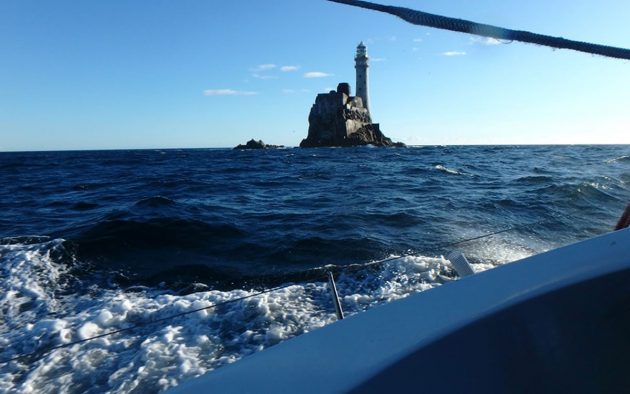A complex weather pattern could favour the smaller yachts in the 394-boat fleet, in a race that will see a long struggle west capped by a fast finish
One of the most challenging and tactical Fastnet Races of recent years lies ahead for the 394 yachts and 3,000-plus crew beginning the race this Saturday, 3 August.
A complex weather pattern of light winds and a building low pressure will slow the giants of the fleet and may favour the smaller boats, but also mean a fast and wet ride back to the finish in Plymouth.
The 605-mile race from Cowes to Plymouth via the Fastnet Rock is one of the most famous offshore sailing races in the world.
It is infamous for the range of weather conditions competitors must face, and is one of the most tactically demanding, with tidal gates, potential transition zones and local weather variations along the coastal sections.
As such, it attracts many of the world’s top racers including, this year, a huge fleet of 21 super-fast IMOCA 60s whose skippers are competing to accrue mileage and experience to count towards the Vendée Globe solo round-the-world race next year.
Among them will be Britain’s Sam Davies, sailing on the foil-equipped Initiatives Coeur – we caught up with her in Cowes earlier today:
The 394 yachts taking part range from the giant 105ft Ultime trimarans Sodebo, MACIF, Actual and Edmond de Rothschild (which have the course record of 32h 48m in their sights), 100ft maxi Scallywag and former monohull line honours winner Rambler 88.
One of the faster monohulls will be Peter Harrison’s Maxi 72 Sorcha. Navigator Steve Hayles says: “For everything to come together for your size of boat, you’ve got to do some serious preparation and everything has to go right.
“These boats [are separated by] several seconds a mile, they are very, very refined inshore boats that are capable of going offshore, but we don’t have powered winches and we are going to have to muscle our way round the course.”
At the other extreme is designer Simon Rogers, sailing Contessa 32 Assent with his brother, Kit, and their respective daughter and son, Hattie and Jonah. With a waterline length of just 24ft, this is the smallest (and smallest rated) yacht in the fleet.
It is also a significant anniversary for Assent, as 40 years ago in the deadly 1979 Fastnet Race she was one of a minority to finish and won her class.
“It will be a long race for us – we will be lucky to be doing 120 miles a day,” admits Rogers. “Because this yacht finished the 1979 Fastnet Race it is a pilgrimage from that point of view and it is also Jonah’s and Hattie’s first Fastnet.”
“It is a bit of a wake-up call sailing on this size of boat,” he adds. “Doing the DeGuignand Bowl [a qualifying race] in 40 knots upwind, two-handed, suddenly makes you realise what they had to go through in 1979.”
Article continues below…
Beautiful but deadly: Why the Fastnet Rock has always been feared by mariners
It is so notorious among sailors that you could say the Fastnet Rock is the northern hemisphere’s Cape Horn. Legends…
Fastnet Race 1979: Life and death decision – Matthew Sheahan’s story
At 0830 Tuesday 14 August 1979, aged 17, five minutes changed my life. Five minutes that, despite the stress of…
In contrast, this year, the first 24 hours of the race is likely to be very hard work because of the light winds and pace of sail changes.
“At the moment at the start time we are looking at a south-easterly and there could be very little at that point,” predicts pro navigator and meteorologist Libby Greenhalgh.
“But ultimately what we are looking at is this lovely high pressure is going to slowly give way to a low pressure that is out to the west of the UK and that will bring south-south-westerly or south-westerly winds.
“So there is what we are calling a transition zone where there is not a lot of pressure there, and what you are looking at is do you negotiate it at the shortest distance.
“That also means the faster boats are not going to be able to get away in these first 24 hours, and the south-easterly will continue for the smaller boats.
“Effectively that will be a reasonable gain for the smaller boats and make that transition zone smaller for [them] than the big boats.
“That south-westerly breeze will be building though and some the IRC classes should see 25-30 knots on the way back from the Rock, so it will be for many a wet but fast sleigh ride home.”
The race begins on Saturday 3 August with class starts beginning from 1230. This will be live-streamed from the Royal Ocean Racing Club website.
We will have regular updates, interviews from the finish and boat walkthroughs on the Yachting World Facebook page.
2019 Rolex Fastnet Race facts
- This is the 48th edition of the race. It runs every other year
- The first race was held in 1925 and had only seven entries. The winner, the gaff cutter Jolie Brise, took 147 hours to finish
- There are entries from 26 countries.
- The largest entry is from the UK, with 185 boats, then France, with 98 entries.
- The Fastnet Race passes several famous landmarks: The Needles; Portland Bill; The Lizard; the Fastnet Rock, Bishop Rock (Scilly Isles), and Plymouth breakwater.
- The Fastnet lighthouse is only six miles from the nearest harbour on the coast of Ireland, Crookhaven.
- Before every Fastnet Race a church service is held to remember the 18 sailors who perished in the tragic 1979 Fastnet Race.






